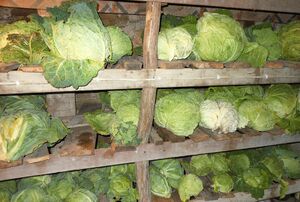Root cellar


A root cellar is a fully or partially underground structure used to store vegetables, fruits, nuts, and other foods in a cold, dark, and humid environment as a method of food preservation. The name originated from a traditional focus on storing root crops like onions, carrots, and potatoes. Root cellars are used for passive refrigeration but require proper design considerations. If a root cellar is impractical but a large amount of refrigeration is needed, consider a well insulated room with a CoolBot.
Five major elements of root cellars are:
- Ventilation
- Earth-shelter
- Darkness
- Humidity
- Shelving or Storage
Ventilation
Some produce gives off ethylene gas, which can cause other produce to spoil. Also, a tightly sealed cellar will increase the risk of mold. Make sure fresh air can get in, stale air can get out, and air can circulate around the produce.
Earth-shelter
Soil insulates and maintains a cool temperature. A packed earth floor or gravel floor is better than concrete for keeping moisture levels high.
Darkness
Light can trigger sprouting, so if you have a window in your root cellar, keep it covered, and don’t leave the lights on.
Humidity
A high humidity level of 85-95% keeps produce from drying out. Humidity that is high enough for produce may cause canning jar lids to rust, so be sure to check lids and rotate stock if you store canned goods in the root cellar.
Shelving
Wood shelving and bins are naturally antibacterial. Wood also conducts heat more slowly than metal, and doesn't rust. Avoid treated wood, and stick to those that are naturally rot resistant.